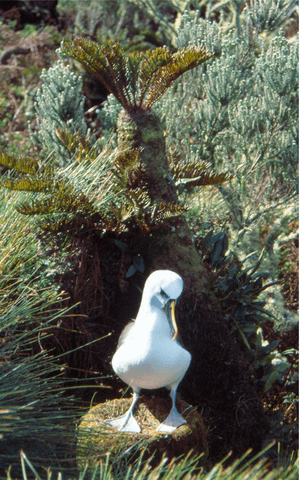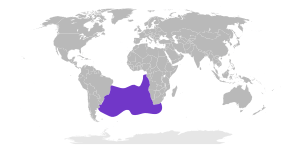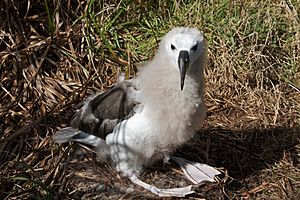Atlantic yellow-nosed albatross facts for kids
Quick facts for kids Atlantic yellow-nosed albatross |
|
|---|---|
 |
|
| Conservation status | |
| Scientific classification | |
| Genus: |
Thalassarche
|
| Species: |
chlororhynchos
|
 |
|
| Synonyms | |
|
Thalassarche chlororhynchos chlororhynchos |
|
The Atlantic yellow-nosed albatross (Thalassarche chlororhynchos) is a large seabird that belongs to the albatross family. Its scientific name comes from Ancient Greece. Thalassarche means "sea commander," and chlororhynchos means "yellow bill."
This type of albatross is a small mollymawk. It was once thought to be the same species as the Indian yellow-nosed albatross. Some experts still consider them to be the same bird.
Contents
About Mollymawks
Mollymawks are a kind of albatross. They belong to the family Diomedeidae. This family is part of a larger group of birds called Procellariiformes. This group also includes shearwaters, fulmars, storm petrels, and diving petrels.
These birds have some special features:
- They have unique nasal passages on their upper bill, called naricorns. The albatross's nostrils are on the sides of its bill.
- Their bills are made of seven to nine hard plates.
- They can produce a special "stomach oil." This oil is stored in their stomach. They use it to defend themselves from predators. It also provides a lot of energy for their chicks and for adults during long flights.
- They have a salt gland above their nose. This gland helps them remove salt from their bodies. They drink a lot of ocean water, so this gland is very important. It releases a salty liquid from their nose.
What They Look Like
The Atlantic yellow-nosed albatross is about 81 cm (32 in) long. It has a black and white body, typical for a mollymawk. Its head is grey, and it has a large patch around its eye. The back of its neck is white.
Its bill is black, with a yellow stripe on top and a pink tip. Its back, tail, and upper wings are blackish-grey. The underside of its body is mostly white. The underside of its wings has a thin black edge.
Young albatrosses look similar to adults. However, they have a white head and a black bill. You can tell them apart from the Indian yellow-nosed albatross because their head is darker. They are also smaller than other mollymawks. Their wings are especially narrow.
How They Behave
What They Eat
This mollymawk eats different kinds of sea creatures. It feeds on squid, fish, cuttlefish, and crustacea (like crabs and shrimp). Sometimes, the yellow-nosed albatross hunts for food at night.
How They Breed
Like all albatrosses, they live in large groups called colonies. They build their nests in unusual places. You can find them in bushes, on top of cliffs, or among tree ferns.
They build pedestal nests. These nests are made of mud, peat, feathers, and plants. They lay one egg in these nests. This usually happens in September or early October. The chick leaves the nest in late March or April. They breed every year.
Where They Live
Atlantic yellow-nosed albatrosses build their nests on islands in the middle of the Atlantic Ocean. These islands include Tristan da Cunha (like Inaccessible Island, Middle Island, Nightingale Island, and Stoltenhoff Island) and Gough Island.
When they are not nesting, they fly across the southern Atlantic Ocean. They can be found from South America to Africa. Their range is between 15°S and 45°S latitude.
Protecting Them
The IUCN lists this species as endangered. This means they are at high risk of disappearing. Their total range covers about 16,800,000 square kilometers (6,500,000 sq mi). Their breeding areas are much smaller, about 80 square kilometers (31 sq mi).
In 2001, experts estimated the population. There were about 5,300 breeding pairs on Gough Island. On Tristan da Cunha Island, there were between 16,000 and 30,000 breeding pairs. Other islands had smaller numbers: 4,500 on Nightingale Island, 100 to 200 on Middle Island, 500 on Stoltenhoff Island, and 1,100 on Inaccessible Island. This means there were between 55,000 and 83,200 adult birds in total. However, these numbers are from 1983 and are quite old. Trends suggest their population has dropped by 50% over 72 years.
The biggest danger to these birds is longline fishing. This type of fishing uses very long lines with many hooks. Albatrosses can get caught on the hooks and drown. It is now against the law to hunt their chicks or adult birds.
People are working to help save these birds. They are counting the birds on Gough Island. Both Gough Island and Inaccessible Island are protected nature preserves. Gough Island is also a World Heritage Site. The birds on Tristan da Cunha are being tracked and counted remotely. The South East Atlantic Fisheries Organisation has also made a rule. It says that all fishing boats must use a tori line (a line that scares birds away from hooks) and drop lines at night.
See also
 In Spanish: Albatros chlororrinco para niños
In Spanish: Albatros chlororrinco para niños



